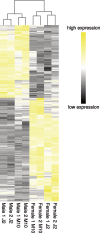De Novo Transcriptome Assembly and Sex-Biased Gene Expression in the Cyclical Parthenogenetic Daphnia galeata
- PMID: 27604882
- PMCID: PMC5174735
- DOI: 10.1093/gbe/evw221
De Novo Transcriptome Assembly and Sex-Biased Gene Expression in the Cyclical Parthenogenetic Daphnia galeata
Abstract
Daphnia species have become models for ecological genomics and exhibit interesting features, such as high phenotypic plasticity and a densely packed genome with many lineage-specific genes. They are also cyclic parthenogenetic, with alternating asexual and sexual cycles and environmental sex determination. Here, we present a de novo transcriptome assembly of over 32,000 D. galeata genes and use it to investigate gene expression in females and spontaneously produced males of two clonal lines derived from lakes in Germany and the Czech Republic. We find that only a low percentage (18%) of genes shows sex-biased expression and that there are many more female-biased gene (FBG) than male-biased gene (MBG). Furthermore, FBGs tend to be more conserved between species than MBGs in both sequence and expression. These patterns may be a consequence of cyclic parthenogenesis leading to a relaxation of purifying selection on MBGs. The two clonal lines show considerable differences in both number and identity of sex-biased genes, suggesting that they may have reproductive strategies differing in their investment in sexual reproduction. Orthologs of key genes in the sex determination and juvenile hormone pathways, which are thought to be important for the transition from asexual to sexual reproduction, are present in D. galeata and highly conserved among Daphnia species.
Keywords: crustaceans; environmental sex determination; genetic variation; juvenile hormone pathway; males; sexual dimorphism.
© The Author 2016. Published by Oxford University Press on behalf of the Society for Molecular Biology and Evolution.
Figures





Similar articles
-
Profiling sex-biased gene expression during parthenogenetic reproduction in Daphnia pulex.BMC Genomics. 2007 Dec 18;8:464. doi: 10.1186/1471-2164-8-464. BMC Genomics. 2007. PMID: 18088424 Free PMC article.
-
Identification of General Patterns of Sex-Biased Expression in Daphnia, a Genus with Environmental Sex Determination.G3 (Bethesda). 2018 May 4;8(5):1523-1533. doi: 10.1534/g3.118.200174. G3 (Bethesda). 2018. PMID: 29535148 Free PMC article.
-
Strong differences in the clonal variation of two Daphnia species from mountain lakes affected by overwintering strategy.BMC Evol Biol. 2011 Aug 8;11:231. doi: 10.1186/1471-2148-11-231. BMC Evol Biol. 2011. PMID: 21824417 Free PMC article.
-
Males on demand: the environmental-neuro-endocrine control of male sex determination in daphnids.FEBS J. 2015 Nov;282(21):4080-93. doi: 10.1111/febs.13393. Epub 2015 Aug 21. FEBS J. 2015. PMID: 26237283 Review.
-
Environmentally Dependent Alteration of Reproductive Strategies and Juvenile Hormone Signaling in Daphnia (Crustacea: Cladocera).Zoolog Sci. 2025 Feb;42(1). doi: 10.2108/zs240054. Zoolog Sci. 2025. PMID: 39932751 Review.
Cited by
-
Daphnia galeata responds to the exposure to an ichthyosporean gut parasite by down-regulation of immunity and lipid metabolism.BMC Genomics. 2018 Dec 14;19(1):932. doi: 10.1186/s12864-018-5312-7. BMC Genomics. 2018. PMID: 30547741 Free PMC article.
-
Hybridization Dynamics and Extensive Introgression in the Daphnia longispina Species Complex: New Insights from a High-Quality Daphnia galeata Reference Genome.Genome Biol Evol. 2021 Dec 1;13(12):evab267. doi: 10.1093/gbe/evab267. Genome Biol Evol. 2021. PMID: 34865004 Free PMC article.
-
Contrasting patterns of divergence at the regulatory and sequence level in European Daphnia galeata natural populations.Ecol Evol. 2019 Feb 12;9(5):2487-2504. doi: 10.1002/ece3.4894. eCollection 2019 Mar. Ecol Evol. 2019. PMID: 30891195 Free PMC article.
-
Combining independent de novo assemblies to optimize leaf transcriptome of Persian walnut.PLoS One. 2020 Apr 28;15(4):e0232005. doi: 10.1371/journal.pone.0232005. eCollection 2020. PLoS One. 2020. PMID: 32343733 Free PMC article.
-
Insights into the genetic basis of predator-induced response in Daphnia galeata.Ecol Evol. 2020 Oct 18;10(23):13095-13108. doi: 10.1002/ece3.6899. eCollection 2020 Dec. Ecol Evol. 2020. PMID: 33304520 Free PMC article.
References
-
- Alexa A, Rahnenfuhrer J. 2010. topGO: enrichment analysis for Gene Ontology. R package version 2.18.0.
-
- Bellés X, Martín D, Piulachs MD. 2005. The mevalonate pathway and the synthesis of juvenile hormone in insects. Annu Rev Entomol. 50:181–199. - PubMed
Publication types
MeSH terms
LinkOut - more resources
Full Text Sources
Other Literature Sources

